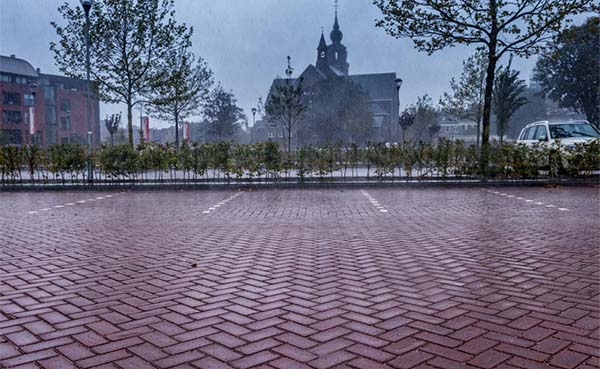Adapting our public space to climate change is one of the biggest challenges facing the Dutch government and the construction sector. Vandersanden takes the lead in climate adaptation and develops solutions that provide an answer to torrential rains and drying soils.
Our climate is changing. Across Europe and beyond, summers are getting hotter and periods of heavy rainfall accelerate. Wageningen University estimates the total damage from climate change in the Netherlands to be at least €80 billion by 2050, if adaptation measures are not taken. So the government formulated the ambition to make all public spaces climate-resilient by 2050.
Heat and prolonged drought lead to a lowering of the groundwater level and water shortages affecting agriculture, among other things. In contrast, during periods of intense rainfall, the potential for floods and floods increases, particularly in urban areas that tend to be less resilient to climate change.
This paradox – our public space is overburdened with too much and too little water – presents a major challenge to governments: How do we design our public space in such a way that we can not only drain rainwater, but also retain it?
Climate adaptation in Vandersanden
As a family business, we ask ourselves every day how we can contribute to an enjoyable living environment that anticipates the environmental challenges of today and tomorrow. We think of generations, not years. That’s why we’re excited to help build a public space that will remain sustainable, climate-resistant, beautiful and of high quality not only today, but also in 10, 50 or 100 years.
We are committed to climate-resilient solutions according to the following three principles:
- Customization in the function of local needsClimate adaptation goes beyond a range of products. Every neighborhood in the city is different from the village center. Anyone wishing to invest in sustainability should develop system solutions that respond to (excessive) local challenges. Consider, for example, groundwater flows, subsoil type, differences in elevation affecting water flow, paving and buildings, groundwater levels, precipitation intensity, and local annual precipitation.
- Simplicity and accessibility: We should embrace climate adaptation, so it shouldn’t become too complicated. At Vandersanden, we strive to find climate-resilient solutions that contractors can also achieve without major changes to the way they work. We believe in solutions that are straightforward, manageable and not too complicated.
- Attractiveness and quality: According to Vandersanden, municipalities do not have to make a compromise between attractiveness and sustainability when designing their public spaces. Climate-adapted solutions must have the same quality standards as classic products and must look beautiful and of high quality.
Doing excercise
How to combat floods and scarcity concretely?
In the past, the dogma was to drain the rainwater as fast as possible. This philosophy is now outdated: we should try to conserve water. By draining rainwater very quickly, we break down the natural regeneration of the groundwater system, which is especially important during periods of prolonged heat and drought.
At Vandersanden, we believe in the power of waterproofing paving as a solution to increasing floods and droughts.
Rainwater seeps into the place of its fall through the paving that leaks from the water. In infrastructure, water can sink into the ground on the site or, for example, be discharged with a delay to WADI or surface water. By separating rainwater, we prevent overload and flooding in the sewage system. Wastewater treatment plants also perform better if the wastewater is not diluted with rainwater. In addition, waterproofing paving also helps prevent long periods of drought: by accumulating water in the ground, the groundwater level is maintained and the risk of dehydration and salinization is reduced.
For this reason, Vandersanden has developed Drainflow: Hydrophilic Paving Bricks with classic paving brick quality and waterproofing properties. Stones can be mechanically processed and the application avoids other complex and costly interventions such as creating separate rainwater ducts. It is functional and fits well with the existing built environment.
In short: Water passage pavers, along with the right substrate, are a simple, beautiful and sustainable solution that protects our public space from the impact of climate change.
What does the future hold?
Vandersanden is proud of our ability to contribute to improving the quality of life in our public space through innovative solutions and tailored advice. This way we help build beautiful and sustainable cities and villages across Europe.
We are already making climate adaptation a priority today, but we are also thinking about the future. The horizon is currently set for 2050, but climate change will remain a major challenge for decades and centuries after. This is why we are currently working on developing CO2 neutral and even CO2 negative stones. We want to reduce the environmental impact of our bricks for a Life Cycle Assessment (LCA) and Environmental Cost Index (MKI) environment. Our new brick kiln in Tolkamer is already helping to significantly reduce CO2 emissions today.
Finally, Vandersanden will also develop as a company.
In a world with an increasingly complex climate, Vandersanden is growing from a producer of facades and paving bricks into a partner for governments who want to design their public spaces in a sustainable and climate-resilient manner. By joining forces with our partners and municipalities, we are taking a step forward in making public spaces more sustainable in the Netherlands and beyond.
Read also:


“Coffee buff. Twitter fanatic. Tv practitioner. Social media advocate. Pop culture ninja.”











More Stories
“Ask at least one question in return.”
According to research, people with this sleep rhythm live longer.
13 municipalities in the province of Seville have mosquitoes carrying the Nile virus